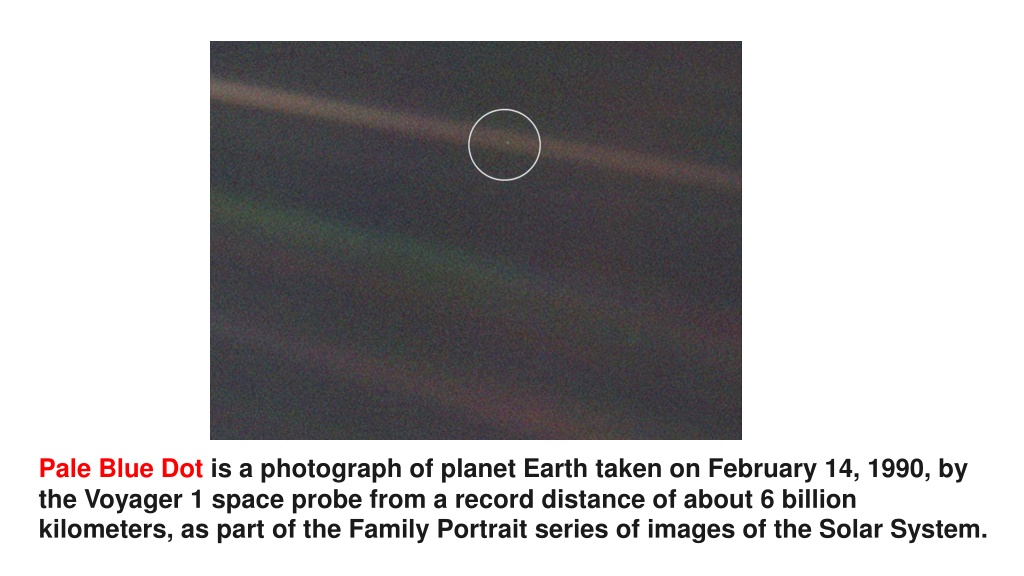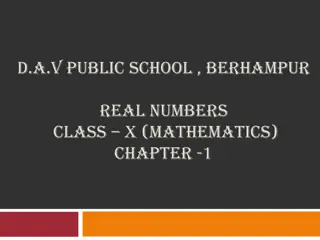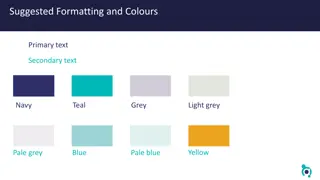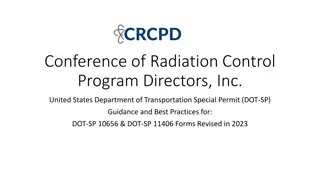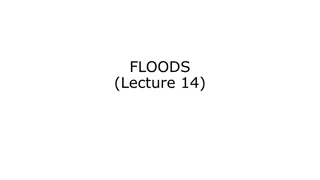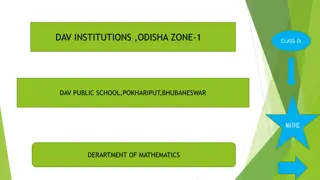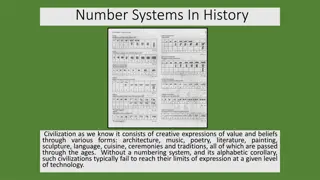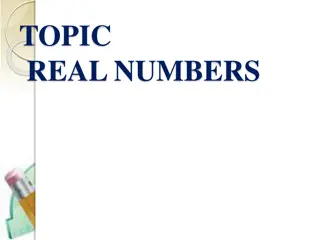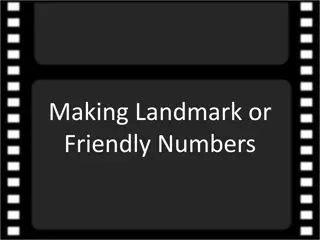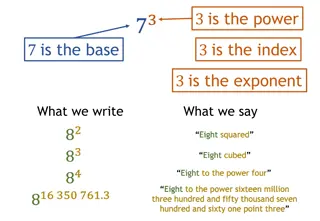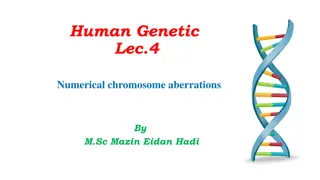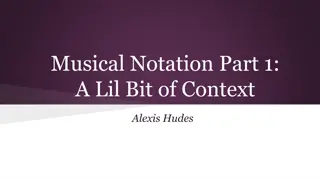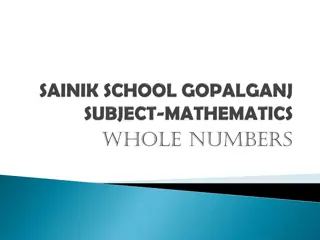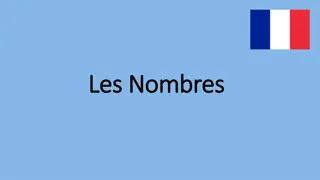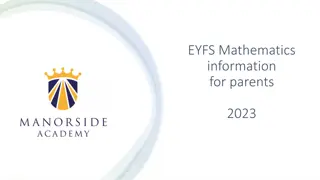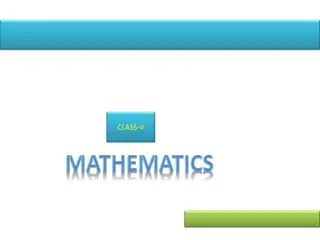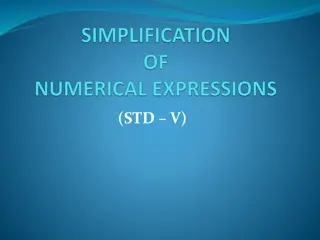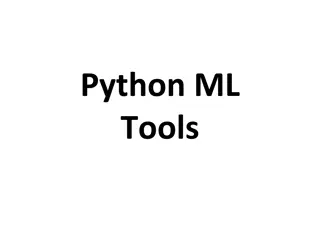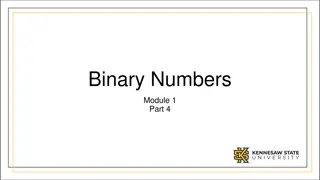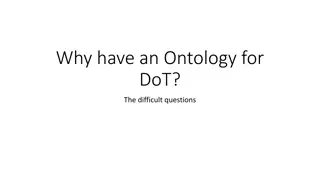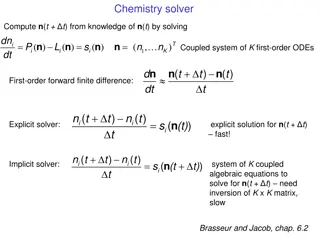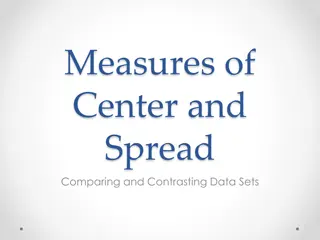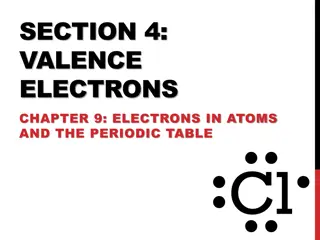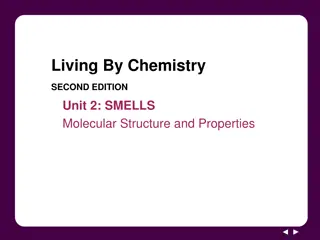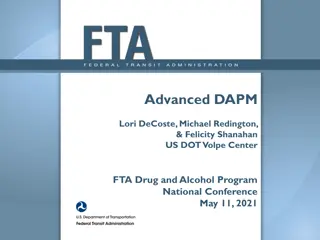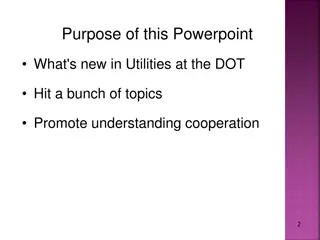Evolution of Numerical Systems: From Pale Blue Dot to Babylonian Numbers
Tracing back to the Pale Blue Dot photograph of Earth, discover the evolution of numerical systems from scratch marks on bones to sophisticated Babylonian base-60 system. Sumerians used tokens for counting, leading to the birth of arithmetic, while Babylonians utilized a positional number system. Explore the significance of number representations and the legacy of the Babylonian base-60 measurement in time and geometry.
Download Presentation

Please find below an Image/Link to download the presentation.
The content on the website is provided AS IS for your information and personal use only. It may not be sold, licensed, or shared on other websites without obtaining consent from the author. Download presentation by click this link. If you encounter any issues during the download, it is possible that the publisher has removed the file from their server.
E N D
Presentation Transcript
Pale Blue Dot is a photograph of planet Earth taken on February 14, 1990, by the Voyager 1 space probe from a record distance of about 6 billion kilometers, as part of the Family Portrait series of images of the Solar System.
Presently, the earliest known archaeological evidence of any form of writing or counting are scratch marks on a bone from 150,000 years ago. But the first really solid evidence of counting, In the form of the number one, is from a mere twenty-thousand years ago. An ishango bone was found in the Congo with two identical markings of sixty scratches each and equally numbered groups on the back. These markings are a certain indication of counting and they mark a defining moment in western civilization.1
In Suma, around 4,000 BCE, Sumerians used tokens to represent numbers. An advantage of using tokens to represent numbers is that in addition to adding tokens you can also take away, giving birth to arithmetic, an event of major significance. The Sumerian s tokens is of great importance in our society, because it made it possible to assess wealth, calculate profit and loss and to collect TAXes!!!!. Keep permanent records. This is the world s first writings and accounting system. In comparison: First step pyramid ....around 2800 BC
Around 1900 BC The Babylonian number system. The Babylonians `wrote' on wet clay by pressing a stylus or wedge into it in one of a small number of ways. The Babylonian number system, already from a very early era, was remarkably sophisticated. It was positional, They had to remember only 2 Symbols instead of ten and had the base ten without the zero.
Babylonian number system had a base of 60, inherited from the Sumerian and Akkadian civilizations, and possibly motivated by the large number of divisors that 60 has. The sexagesimal measurement of time and of geometric angles is a legacy of the Babylonian system.
Number 1 was written with a single stroke `stroke' Numbers 2 through 9 were written by combining multiples of a single stroke: The number 10 was written in a single character For example, 11 was written 20 30 40 50
1500 BCE The Babylonians invented trigonometry. The cuneiform inscriptions on Plimpton 322 suggest the Babylonians used a form of trigonometry based on the ratios of the sides of a triangle rather than the more familiar angles, sines, and cosines.
Babylonian tablet YBC 7289 showing the sexagesimal number 1;24,51,10 approximating 2 YBC Yale Babylonian Collection
The ten fingers on two hands, is a possible starting point of the decimal counting as observed with children.
Decimal notation is a base 10, positional notation. It is the Hindu-Arabic numeral system. It can refer to non-positional systems such as Roman or Chinese numerals which are also based on powers of ten.
The world's earliest decimal multiplication table was made from bamboo slips, dating from 305 BC, during the Warring States period in China.
Positional system , Decimal, The base or Radix is 10, The number is presented as: 10nAn + 10n-1An-1+ 10n-2An-2 +.......... + 101A1+ 100A0 Example: A number such as 3471 is written as 103. 3 + 102. 4 + 101 . 7 + 100. 1 Normally the coefficients are written and the positions are assumed. More general: 10nAn + 10n-1An-1+ 10n-2An-2 +.......... + 101A1+ 100A0 . 10-1A-1+ 10-2A-0 ....... decimal point
Positional Binary numbers, The base or radix is 2, so there is only two numbers 0 and 1 2nAn + 2n-1An-1+ 2n-2An-2 +.......... + 21A1+ 20A0 Example: A number such as 1101 (1310) is written as: 23. 1 + 22. 1 + 21 . 0 + 20. 1 8 + 4 + 0 + 1 =1310 Normally the coefficients are written and the positions are assumed. More general: 2nAn + 2n-1An-1+ 2n-2An-2 +.......... +21A1+ 20A0 . 2-1A-1+ 2-2A-0....... binary point
Common number systems that we might need: Binary base = 2 Octal base =8 Decimal base =10 Hexadecimal base =16
Binary Prefixes or symbols The prefix represents the power of 1000, and means 10n 2 10 Kilo or K =1,024 bits or , 103 220 Mega M =1,048,576 bits or 106 2 30 Giga G = 1,073,741,824 bits or 109 240 Tera T= 1,099,511,627,776 bits or 10 12 2 50 Petabyte (1 000 000 000 000 000 bytes) Exabyte (2 60 ), Yottabyte ( 2 70) , Xenottabyte (2 80) , Shilentnobyte (2 90) , Demengemgrottebyte (2 100 ) .......
Weight of the digital information storage 1 bit: A binary decision 1 byte: A single character,, (8 bits) 10 bytes: A single word 1 K Byte: A paragraph 2K Bytes A page 100 K Bytes: A very low resolution Photograph 1 M Byte: A small Novel 2 M byte: A high resolution Photograph 5 M byte: A complete works of Shakespeare 10 M byte: A minute of High fidelity sound 100 M bytes: A meter of Shelfed books 800 M bytes: A CD-ROM 1 Giga Bytes: A pick up truck filled with paper 20 G Bytes: A good collection of works of Beethoven 1 Tera byte : 50,000 trees made into printed paper 10 Tera bytes: The printed collection of the US Library of Congress.
Binary Addition Example 1: Example 2: Augend 0 1 0 1 1 + Addend 0 1 0 1 0 ----------------- Results 1 0 1 0 1 ========================================================== Augend = 1 + 2 + 0 + 8 =1110 Addend = 0 + 2 + 0 + 8 =1010 Results = 1 + 0 + 4 +0 + 16 = 2110 Results = 0 + 0 + 0 +8 + 16 = 2410 Augend 0 1 0 1 0 + Addend 0 1 1 1 0 ----------------- 1 1 0 0 0 Augend = 0 + 2 + 0 + 8 =1010 Addend = 0 + 2 + 4 + 8 =1410
Binary Subtraction Example 1: Example 2: Minuend 0 1 0 1 1 - Subtrahend 0 1 0 1 0 Results 0 0 0 0 1 Minuend 0 1 0 1 1 - Subtrahend 0 0 1 1 0 ----------------- ----------------- 0 0 1 0 1 Minuend = 1 + 2 + 0 + 8 =1110 Subtrahend = 0 + 2 + 0 + 8 =1010 Results = 1 + 0 + 0 +0 + 0 =0110 Minuend = 1 + 2 + 0 + 8 =1110 Subtrahend = 0 + 2 + 4 + 0 =610 Results = 1 + 0 + 4 +0 + 0 = 510
Binary Multiplication Example 1 Example 2 Multiplicand 1 1 0 1 1 Multiplier 1 0 1 ----------------- 1 1 0 1 1 1 1 0 1 1 ---------------------- Results 1 0 0 0 0 1 1 1 =========================================== Multiplicand 1 + 2 + 0 + 8 + 16 = 2710 Multiplier 1 + 0 + 4 = 510 Results 1 + 2 + 4 + 0 + 0 +0 + 0 + 128 =13510 Multiplicand 1 0 0 1 1 Multiplier 1 1 1 ----------------- 1 0 0 1 1 1 0 0 1 1 ---------------------- Results 1 0 0 0 0 1 0 1 =========================================== Multiplicand 1 + 2 + 0 + 0 + 16 = 19 10 Multiplier 1 + 2 + 4 = 710 Results 1 + 0 + 4 + 0 + 0 +0 + 0 + 128 =13310 0 0 0 0 0 1 0 0 1 1
Number conversion: Decimal to Binary Example: Convert the number 5210 To Binary Integer Quotient Remainder Binary Coefficient 52/2 26 0 ao=0 26/2 13 0 a1 =0 13/2 6 1 a2 =1 6/2 3 0 a3 =0 3/2 1 1 a4 =1 1/2 0 1 a5 = 1 The final number is a5 a4 a3 a2 a1 a0 or 110100 32+16+4=5210
Number conversion: Decimal to Binary Example: Convert the number 139. 7510 To Binary This is done in two steps First the number is converted and then the decimal part Integer Quotient Remainder Binary Coefficient 139/2 69 1 ao=1 69/2 34 1 a1 =1 34/2 17 0 a2 =0 17/2 8 1 a3 =1 8/2 4 0 a4 =0 4/2 2 0 a5 = 0 2/2 1 0 a6 = 0 1/2 0 1 a7 = 1 The final number is a7a6a5 a4 a3 a2 a1 a0 or 10001011 = 13910
Decimal to Binary , the decimal part: Example: 0.7510 to Binary Integer + Fraction 0.7 5 * 2 1 0.5 0.5 0 * 2 1 0 .0 The result is 0 .112 So the Total conversion result of Decimal to Binary is : 139.7510 is 10001011. 11 2
Number Conversion Decimal to octal Octal is base 8 numbers expressed as follows: 8nAn + 8n-1An-1+ 8n-2An-2 +.......... + 81A1+ 80A0 Where A can be 0,1,2,3,4,5,6,7 Example: Convert 34310 to Octal: Integer Fraction 343/8 42 7 42/8 5 2 5/8 0 5 Results 34310 = 5278 The answer is from the Fraction part of the procedure Checking the results 5 * 82 + 2 * 81 + 7 * 80 5* 64 + 2 * 8 + 7 =34310
Number Conversion Hexadecimal is base 16 number system as follows: 0,1,2,3,4,5,6,7,8,9,A,B,C,D,F It is used in communicating Binary numbers, for ease of use. Where Decimal Binary A = 10, 1010 B = 11, 1011 C= 12, 1100 D= 13, 1101 E= 14, 1110 F= 15 1111
Number Conversion Example: Convert the Hexadecimal number AD7B16 to Binary AD7B16 = 1010 1101 0111 1011 Example: Convert the Following Binary number to Hexadecimal 1111100101101110001010 Starting from the right separate each 4 bits as follows, add zero to the left if necessary: 0011 1110 0101 1011 1000 1010 3 E 5 B 8 A Answer is 3E5B8A
Decimal Binary Octal Hexadecimal 0 0000 0 0 Table 0f Numbers with different bases 1 0001 1 1 2 0010 2 2 3 0011 3 3 4 0100 4 4 5 0101 5 5 6 0110 6 6 7 0111 7 7 8 1000 10 8 9 1001 11 9 10 1010 12 A 11 1011 13 B 12 1100 14 C 13 1101 15 D 14 1110 16 E 15 1111 17 F
Negative binary number representation for n=3, 2?= 8 values Decimal number Binary number Sign and Magnitude One s Complement Two s Complement 0 000 000 0 000 0 000 0 1 001 001 1 001 1 001 1 2 010 010 2 +ve 010 2 +ve 010 2 +ve 3 011 011 3 011 3 011 3 4 100 100 --0 100 --3 100 --4 5 101 101 --1 10 1 --2 101 --3 6 110 110 --2 --ve 110 --1 -ve 110 --2 --ve 7 111 111 --3 111 -- 0 111 --1 +0 and 0 Hardware Implementation problem +0 and 0 Hardware Implementation problem 0nly one 0 Simple Hardware Overflow Detection Please note that the Most Significant Bit (MSB) for a +ve number is 0 and the +ve number does not change. ONLY the the ve number has its MSB as 1 and the magnitude changes according to the scheme used.
An easier method to get the negation of a number in 2's complement is as follows: Sign bit +ve number Example 1 0 0101100 1 1010100 Example 2 0 0101001 1 1010111 1. Starting from the right, find the first '1' 2. Invert all of the bits to the left of that one Advantage of the 2 s complement number system is that we can use the same hardware circuit to do the addition and the subtraction Sign bit - ve , 2 s complement number
Addition with Binary Numbers Possibility of digits addition: 0+ 0 = 0 0+1=1+0 = 1 1+1 =10 carry=1 sum=0 4-bit unsigned number Example_2: Add A= 1 1 0 1 Augend 1310 B= 0 1 1 0 Addend 610 --------------------------------- Sum= 1 0 0 1 1 310 because the overflow is discarded, overflow 4-bit unsigned number Example_1: Add A= 0 1 0 1 Augend 510 B= 0 1 1 0 Addend 610 --------------------------------- Sum= 1 0 1 1 1110
Subtraction with binary Possibility of digits Subtraction: 0 - 0 = 0 1 - 1 = 0 0 - 1 = 11 Borrow =1 Difference =1 1 - 0 =1 4-bit unsigned number Example_2: Add A= 1 1 0 1 Minuend 1310 B= 1 1 1 0 Subtrahend 1410 --------------------------------- Sum= 1 1 1 1 1 3110 ? Or 1510 4-bit unsigned number Example_1: Minuend A = 1 0 1 0 1010 Subtrahend B = 0 1 0 0 410 --------------------------------- Difference 0 1 1 0 610 Overflow ? Incorrect results
Multiplication with Binary Numbers Example: Multiply the following two 4-bit unsigned binary numbers A=1101 =1310 B=1001 = 910 1 1 0 1 multiplicand 1 0 0 1 multiplier ---------------------------------- 1 1 0 1 0 0 0 0 partial products 0 0 0 0 1 1 0 1 1 1 1 0 1 0 1 = 127 10
Subtraction with 2complement Example_2 Perform the following operation: B-A, A & B are 5 bit signed numbers A= 01001 910 B=00011 310 Example_1 Perform the following operation: A-B, A&B are 5 bit signed numbers A= 01001 910 B=00011 310 2 s of A = A +1 =10110 + 1 = 10111 1 0 1 1 1 2 complement of A 0 0 0 1 1 B 1 Complement 1 1 1 0 0 1 plus 1 2 complement of B 1 1 1 0 1 -B 0 1 0 0 1 Add result is 1 1 0 1 0 a -ve number to get its value, complement 1010 and add 1 0101 1 1 0110 -610 0 0 1 1 0 = +610 Sign bits Subtraction is performed as addition
Addition and subtraction with overflow condition With 2 s complement addition and subtraction Two conditions can prevail. When both numbers are +ve or ve. Here, overflow occurs and has to be detected Example_2 Both numbers are ve and in 2 s complement form Add A + B where A= 10011, B= 10010 Both A & B are 5 bit -ve signed numbers Sign 1 0 0 1 1 + -1310 carry 1 0 0 1 0 -1410 1 0 0 1 0 1 Result is +ve, indicating an overflow condition 1)--ve numbers must be initially in 2 complement form 2)End around carry is neglected Example_1 Both numbers are +ve. Add A + B where A= 01011, B= 01100 Both A & B are 5 bit +ve signed numbers 0 1 0 1 1 + 1110 0 1 1 0 0 1210 S 1 0 1 1 1 Result is ve, indicating an overflow condition
Binary Coded Decimal Code, BCD Example: Decimal BCD 0 1 Decimal 10 11 22 13 64 75 99 217 738 599 BCD 0001 0000 0001 0001 0010 0010 0001 0011 0110 0100 0111 0101 1001 1001 0010 0001 0111 0111 0011 1000 0101 1001 1001 0000 0001 2 3 4 5 6 7 8 9 0010 0011 0100 0101 0110 0111 1000 1001
Addition with BCD Example _1 Example _3 Example _2 Add 310 +410= 710 0011 0100 0111 = 710 Add 7710 +8810= 16510 01110111 1000 1000 11111111 0110 0110 + 1 0101 0101 = 1510 0001 + 0001 0110 0101 = 16510 Add 710 +810= 1510 0111 1000 1111 = This is not BCD 0110 0001 0101 = 1510 Numbers greater than 1001 are converted to BCD by adding 0110 to them or in decimal numbers greater than 9 we add 6 to them to convert them to BCD
Decimal Digit Binary BCD Excess-3 Gray code Some useful codes 0000 0000 0011 0000 0 0001 0001 0100 0001 1 0010 0010 0101 0011 2 0011 0011 0110 0010 3 0100 0100 0111 0110 4 0101 0101 1000 0111 5 0110 0110 1001 0101 6 0111 0111 1010 0100 7 1000 1000 1011 1100 8 1001 1001 1100 1101 9 1010 0001 0000 unused 1111 10 1011 0001 0001 unused 1110 11 1100 0001 0010 unused 1010 12 1101 0001 0011 unused 1011 13 1110 0001 0100 unused 1001 14 1111 0001 0101 unused 1000 15
B7 b6 b5 011 ASCII Characters American Standard Code for Information Interchange 000 001 010 100 101 110 111 b4b3b2b1 0 0 0 0 NUL DLE SP 0 @ P p SOH DC1 ! 1 A Q a q 0 0 0 1 STX DC2 2 B R b r 0 0 1 0 ETX DC3 # 3 C S c s 0 0 1 1 The Control Characters are for routing data and arrangement of the text and the printing of the characters EOT DC4 $ 4 D T d t 0 1 0 0 ENO NAK % 5 E U e u 0 1 0 1 ACK SYN & 6 F V f v 0 1 1 0 BEL ETB 7 G W g w 0 1 1 1 BS CAN ( 8 H X h x 1 0 0 0 HT EM ) 9 I Y i y 1 0 0 1 LF SUB * : J Z j z 1 0 1 0 VT ESC + ; K [ k 1 0 1 1 [ FF FS , < L \ l | 1 1 0 0 CR GS - = M ] m } 1 1 0 1 SO RS . > N ^ n ~ 1 1 1 0
